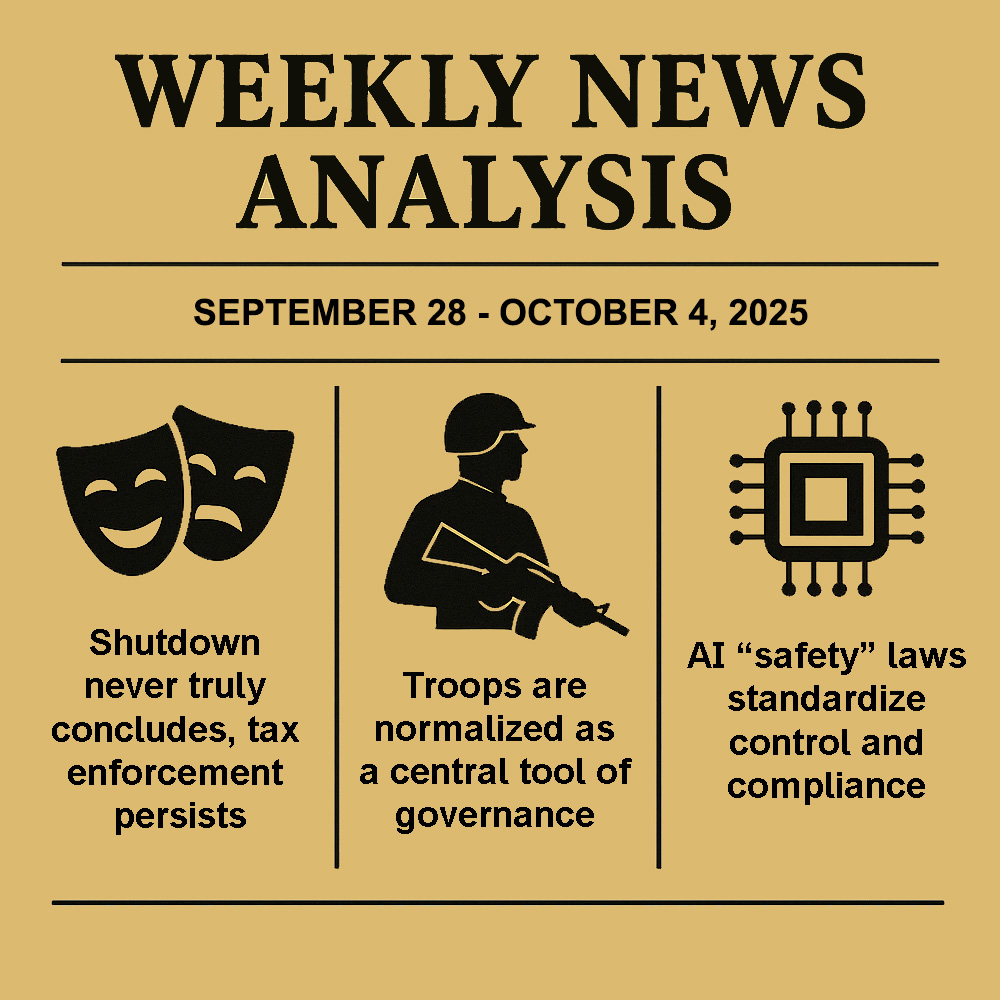
Two stories shaped the week’s narrative: a “shutdown” that never truly concludes, and the ongoing normalization of troops and surveillance as tools of domestic governance. Both are reinforced by a third element—AI rule-making and procurement—that claims to ensure “safety” while formalizing controlled management over citizens and data. Together, they depict a politics of spectacle: dramatic clashes on the surface, with continuous underlying processes.
Across all three topics, the rhetoric relies on emergency framing, scapegoat cycles, and technocratic inevitability. The shutdown story uses cost shock to shift blame while maintaining the state’s core extractive functions; the deployment story prioritizes “order” over law; and the AI story frames preemption as a matter of “safety.” Each one promotes the same hidden idea critiqued in The Fallacious Belief in Government: that centralized authority must expand because, without it, chaos would ensue. The evidence indicates the opposite: chaos is what allows authority to grow.
Shutdown theater system still runs
‘Schumer shutdown’ already cost taxpayers $1.2B in pay to employees not working - Fox News
Government shutdown drags into weekend as Senate Democrats block GOP plan – Fox News
U.S. government begins to shut down most operations after Congress fails to advance - Reuters
Government shutdown live updates, day 3 – CBS News
Shutdowns are presented as stoppages, but the reality remains: tax collection continues, debt payments persist, and “essential” enforcement remains. Headlines focus on spectacle—$400 million per day in back pay owed to 750,000 furloughed workers under a 2019 back-pay law—stirring outrage while reinforcing the idea that only bigger compromises can end the pain. In essence, the crisis highlights the need for more centralized control, not less.
Blame functions as the guiding narrative. One outlet portrays the cost as a partisan waste while blaming the opposition; another counts stalemates and failed votes. The result is the same: a binary blame cycle that turns public attention into fuel for the same machine. Even Reuters’ straightforward reporting on “most operations” closing is paired with details like selective fund freezes—sanctions as governance—keeping the state’s punitive tools active during the “off” switch.
Historically, shutdowns have impacted specific groups—such as contractors, small agencies, park services, and passport offices—enough to cause discomfort but not enough to disrupt the essential tax collection system. The public becomes accustomed to fearing interruptions in daily conveniences while accepting ongoing compliance. The cost argument, based on CBO estimates and echoed by many outlets this week, serves as a weapon: “See what happens without a deal?” But a deal for whom? The guaranteed back-pay means the final burden ultimately falls on taxpayers.
The deeper fallacy lies in confusing “government services” with “governance power.” Services pause; power does not. CBS documents the vote process while the IRS meter, interest payments, and federal law enforcement stay largely unchanged. This is not a shutdown; it’s a pressure tactic. The spectacle justifies the ratchet—temporary pain used to justify permanent expansion.
The shutdown reveals how the operating system functions: first extracting power, then enforcing compliance, and perhaps finally demanding accountability, which is rarely sought. If the government truly served the people, budget disputes would lead to halting tax collection and debt issuance first, not parks and passports. Instead, political actors trade accusations while the administrative core becomes increasingly centralized. That’s why these episodes end with so-called “bipartisan” agreements that expand budgets and strengthen executive authority. The show continues because it is the mechanism itself.
Troops become policy, not law
Judge temporarily blocks use of National Guard in Portland - CNBC
Judge blocks National Guard in Portland - New York Times
‘Assault on oversight’: Hegseth overhaul of military watchdogs spurs concern - Reuters
U.S. scraps Justice Department task force that took on cartels, documents show - Reuters
A federal judge in Oregon issued a temporary restraining order blocking the Trump administration’s move to federalize and deploy 200 National Guard troops to Portland—highlighting that, for now, constitutional limits and state sovereignty still hold some weight. Reports emphasize that the protests on the ground were small and mostly nonviolent, weakening the claim of necessity. The legal action underscores the real conflict: not order versus chaos, but executive power versus the law.
Meanwhile, the Pentagon’s internal review processes are being overhauled. Reuters outlined Defense Secretary Pete Hegseth’s directive to shorten timelines, identify complainants, and pre-screen tips for “credible evidence” within seven days—policies watchdogs worry will discourage whistleblowing and only highlight cases the officials find convenient. If the criteria for which complaints are valid are subordinate to political speed, oversight becomes merely a label, not an obstacle.
Further downstream, Justice is being reshaped to fit a wartime model. Documents reported by Reuters describe the shutting down or restructuring of cartel-targeting units and related roles, while separately, the administration informed Congress that the U.S. is engaged in a “non-international armed conflict” with drug cartels—language that expands executive latitude for force. War becomes the noun that justifies verbs once used for battlefields.
The narrative technique is textbook: inflate threat salience (cartels, urban unrest), conflate civil policing with military doctrine, then reframe rights as security risks. The Oregon ruling illustrates the counter-narrative—courts and states can still resist—but only sporadically. Without strong, independent oversight, temporary checks can easily become PR stunts, while the policy pipeline continues.
Militarizing domestic governance reverses the social contract: the armed forces, which were meant to protect the people, increasingly treat them as a controllable battlespace. “Readiness” becomes the euphemism for domestic deployment; “safety” turns into the justification for repression. The danger is not just a single deployment—it’s the process of normalizing it. Once troops become part of policy, law becomes optional, and tyranny is established.
AI safety as control rails
California Governor Newsom signs landmark AI safety bill SB 53 - Tech Crunch
Hawley & Blumenthal unveil AI evaluation bill - Axios
Trump order harnesses AI to fight childhood cancer - Fox News
Palantir’s deepening foothold in federal agencies - FedScoop
California’s SB-53 is promoted as a safeguard for “frontier models,” featuring required risk disclosures and kill-switch obligations. In D.C., a bipartisan bill suggests federal evaluation systems to test high-risk technology. Meanwhile, the White House promotes a positive application—AI against childhood cancer—closing the rhetorical cycle: regulation that supports expansion, procurement that solidifies vendor dominance, and moral justification that nobody wants to challenge.
What disappears in this framing is the power imbalance. “Safety” requirements increase entry costs that only established firms can afford, while mandated reporting and evaluation push smaller players into compliance relationships with the same agencies that buy the largest contracts. The state becomes both referee and customer. FedScoop’s chronicle of Palantir’s connections across agencies illustrates how evaluation and procurement merge into a single process: evaluate, certify, and then buy.
The logic mirrors public-health mandates during the COVID19 pandemic: define “risk” broadly, centralize permissions, and penalize deviations. This week’s mix—state law, federal bill, presidential order—signals a layered enclosure where legal obligations, budget spending, and patriotic narratives make resistance unthinkable. If you challenge the framework, you’re “anti-safety,” “anti-health,” or “pro-chaos.” The labels perform the censorship work, while contracts solidify the structure.
Technically, the bills target catastrophic misuse; practically, they promote continuous monitoring of models, data, and behavior. Add federal data-fusion tools, and you get governance by dashboard: red-flag scoring for speech, finance, movement, and medicine. The same system that aims to cure cancer also predicts dissent. That’s not a contradiction; it’s the business model.
“AI safety” replaces human judgment with administrative permission. By shifting ethics to compliance and enforcement, as well as algorithmic decision-making, dominance is disguised as “alignment.” Once those control mechanisms are in place, mission creep isn’t just gradual—it’s intentional.
The Ratchet of Safety and Control
Shutdowns that never stop extraction; deployments that treat cities like battlefields; AI laws that standardize obedience — this is one story told three ways. The shared theme is emergency, the logic is centered on centralization, and the rhetoric focuses on care. Every instrument claims to protect you from harm while quietly defining you as the risk.
If you accept the idea that governance must grow to match every fear, the result is predetermined: ratchets never go backwards. The alternative isn’t chaos; it’s decentralization with voluntary cooperation, clear accountability, and genuinely independent checks. Until we reject the performance and its underlying assumptions, the empire will continue to expand—into your wallet, on your streets, and within your code.
Listen to this week's news in verse for a quick recap!


